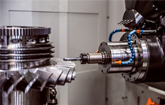Patent Issued to R.F. MacDonald Co. for Safest NOx Emissions Reduction Technology with SCR
SAN FRANCISCO, March 10, 2021 /PRNewswire/ -- On Tuesday, Nov. 24, 2020, the U.S. Patent and Trademark Office granted a patent to R.F. MacDonald Co. for inventing a "process for direct urea injection with selective catalytic reduction (SCR) for NOx reduction in hot gas streams and related systems and assemblies."
SCR requires the use and storage of ammonia-based reagents, which range from high risk to low risk. The R.F. MacDonald Co. patent specifies urea, which is the lowest risk ammonia-based reagent. The only health hazard associated with urea is "possible irritation" as indicated by the Hazardous Materials Identification System.
The urea solution is identical to Diesel Exhaust Fluid (DEF), which is sold worldwide in automotive retail stores for use in diesel motor vehicles.
As shown in the process graphic, urea is injected at each Injection Point into the boiler. As NOx and urea pass through the NOx Reduction Catalyst, NOx is separated into two non-harmful elements Nitrogen (N2) and water (H2O).
There are three types of ammonia-based reagents: anhydrous, aqueous and urea. Both anhydrous and aqueous ammonia carry higher risk and regulatory issues compared to urea as shown in the Ammonia-Based Reagents Comparison Chart.
R.F. MacDonald Co. provides SCR installation and service for each type of ammonia-based reagent. However, installing direct urea injection with SCR is recommended for institutions housing people, such as hospitals and universities, because of its non-hazardous rating. Hospitals use boilers to produce steam for sanitation and universities use boilers to produce hot water for amenities.
As restrictions on NOx emissions and air pollutants increase, industrial and institutional facilities are investing in SCR technology for their boiler systems because SCR has been proven to reach the lowest NOx emissions levels while maintaining boiler efficiency.
R.F. MacDonald Co.'s newly patented SCR technology complies with every emissions limit in California, including the strictest district in the nation: The San Joaquin Valley Air Pollution Control District. California has 35 local air districts responsible for regional air quality, planning, monitoring and facility permitting. Visit the California Air Resources Board (CARB) for more information.
R.F. MacDonald Co.'s history with Low NOx began in the late 1970s after CARB began mandating Low NOx rules and compliance deadlines. At that time, R.F. MacDonald Co. poised itself to be the Low NOx solutions provider in California by retrofitting and installing flue gas recirculation and Ultra-Low NOx burners.
Since 2006, R.F. MacDonald Co. has installed multiple SCR systems each year for various industries within California and Nevada, including hospitals, universities, food processing facilities, power plants and more.
Selection of the appropriate emissions control system requires a detailed evaluation of environmental, technical, safety and economic factors. Solutions currently available to meet Low NOx emissions regulations include burner installation, burner retrofit and SCR installation.
Contact R.F. MacDonald Co. to help guide you through the process at rfmacdonald.com/contact.
U.S. Patent Details
Patent No.: US 10,844,763 B2
Application: R.F. MacDonald Co., Modesto, CA
Issued and Approved: Nov. 24, 2020
PDF: Patent Abstract
AJ Feliz
Director of Engineering
714-257-0900
[email protected]
SOURCE R.F. MacDonald Co.

Related Links
WANT YOUR COMPANY'S NEWS FEATURED ON PRNEWSWIRE.COM?
Newsrooms &
Influencers
Digital Media
Outlets
Journalists
Opted In





Share this article